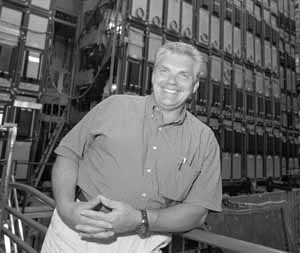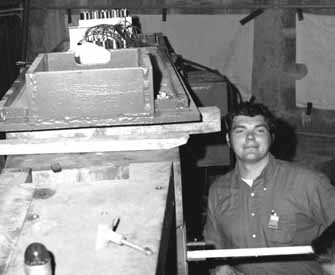 |
|
Delmar Miller: The Man Who Gets Paged 30 Times a Day by Kurt Riesselmann
 He has worked at Fermilab for more than thirty years. He has worked in every accelerator tunnel on site. And he has helped to install numerous beam lines and detector components. Yet one struggles to find a picture of Delmar Miller posing in front of any equipment.
He has worked at Fermilab for more than thirty years. He has worked in every accelerator tunnel on site. And he has helped to install numerous beam lines and detector components. Yet one struggles to find a picture of Delmar Miller posing in front of any equipment.
"We had to work hard to get a picture of him in front of the DZero detector when he and his team completed the fiber tracker installation in July," said Reidar Hahn, photographer of Fermilab's Visual Media Services. For Miller, it's important that the job gets done and that Fermilab's projects are on schedule. Personally, he prefers to stay out of the limelight, always giving credit to colleagues and his group of technicians. Miller's job title is Operational Specialist Senior, and he leads a team of 35 mechanical support people that work on the assembly of the DZero detector. Titles, however, don't mean a thing to him. "Your performance defines you, not your title," says Miller, who is legendary for his uncompromising zeal. He has been working for the DZero collaboration since 1985. For one of his first projects, he worked with Jim Christenson on the end cap calorimeters of the DZero detector, modules that measure the energy of particles that leave the detector in forward or backward direction. His contributions received much praise, and his rigorous approach made him well known. "We cannot even imagine what DZero would be like without Delmar Miller," said Harry Weerts, co-spokesman of the DZero collaboration. "He knows Fermilab inside out. He knows how to get things done." Delmar Miller is supervisor of nearly all the technicians of the DZero group at Fermilab. He and his team have been essential in putting the DZero detector together, assembling and installing detector components, small and large. "Miller is in charge of anything going on in the DZero detector area," Weerts said. "With his experience, he has provided a lot of input in the implementation of the detector construction." Communication is an important aspect of Miller's job. Coordinating the installation of detector parts, which get shipped to Fermilab from various universities and high-energy physics institutions around the world, is critical to meeting DZero's schedule. "E-mail is a wonderful thing," Miller asserts. A pager, of course, is also one of his basic tools. Colleagues estimate that Miller gets paged 30 times a day.
"Many years ago, I worked with Delmar on fixing a muon beam line," said Peter Limon, head of Fermilab's Technical Division. "Its performance was terrible, and we were there to make it work. As Delmar worked on surveying and aligning the magnets, one high-pressured cooling hose came off, spraying water all over the place. While everyone else was still watching, Delmar grabbed the whipping hose and somehow managed to put it back on. He didn't care that he got soaking wet. Something needed to be fixed, and he fixed it." Miller joined Fermilab in 1969 because of the wonderful things a friend, who worked at the lab, had to tell. Supervisors quickly recognized his superb technical skills, quickly solving any problem that occurred. He became one of the first members of the Alignment Group, a special team created by Fermilab's first director Robert Wilson. The group was responsible for beam lines of all accelerators and experiments. Once, Miller even saved an experiment when its malfunctioning electronics caused a fire. He happened to be working in Lab C when the fire started. Quickly assessing the situation, he asked everyone to leave the area, grabbed a fire extinguisher and stopped the fire. "Later, the firemen complained that I used the wrong type of extinguisher," Miller laughs.
To this day, Miller takes a lot of pride in helping Fermilab as much as possible to achieve its goals. And he receives a lot of respect from his colleagues. "He is one of the people that really care about Fermilab," said Limon. Presently, Miller and his team focus on getting the DZero detector ready for taking data during Run II, which starts in March 2001. To achieve that goal, they have taken over jobs that, originally, were never planned to be on their plate. "You can't foresee every single detail," Miller points out. "In every project of this complexity, there are bumps in the road. We just make sure that they don't delay the project." So far the DZero project is on schedule. Miller and his team will work hard to keep it that way.
|
| last modified 9/15/2000 email Fermilab |
FRLsDFx9eyfrPXgV
 Though talking to colleagues is a basic requirement for scheduling work in the detector hall, Miller is happy not to "live in a meeting world." He is glad if he can skip a meeting, relying on co-workers to brief him on details. As a matter of fact, Miller is a man who prefers to take action than to discuss solutions.
Though talking to colleagues is a basic requirement for scheduling work in the detector hall, Miller is happy not to "live in a meeting world." He is glad if he can skip a meeting, relying on co-workers to brief him on details. As a matter of fact, Miller is a man who prefers to take action than to discuss solutions.